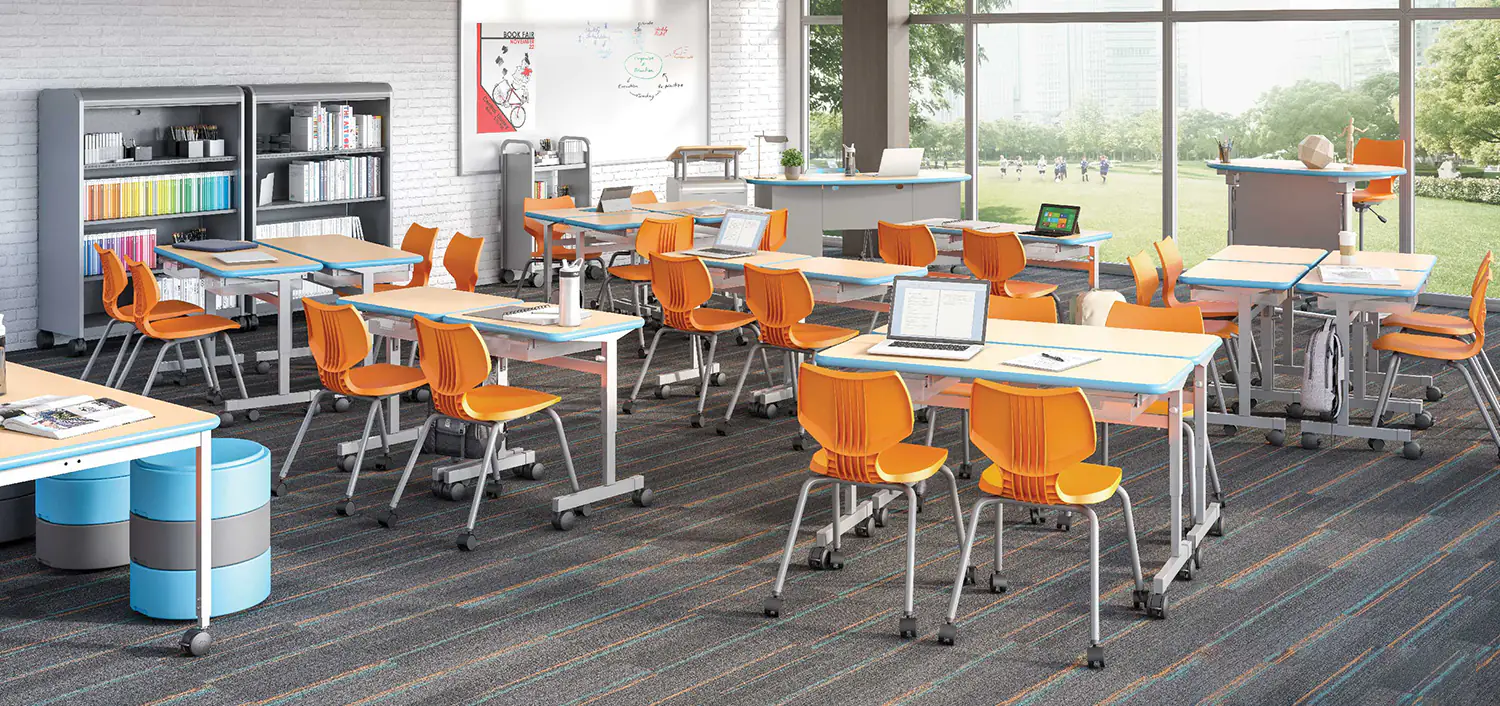Classroom Furniture; The classroom environment has a significant impact on how students learn and engage with educational content. While the pedagogical approach and curriculum are crucial, the physical space and furniture arrangement also play an important role in creating an effective learning environment.
Did you know that the average age of school desks currently in use is nearly 20 years old? With outdated and worn furniture, it’s difficult to maintain an inspiring classroom space. Replacing dated furniture with new, ergonomic designs can completely transform the learning experience for students and teachers alike.
In this blog post, we’ll explore how classroom furniture choices affect the educational experience and provide tips on selecting furniture optimized for today’s learning objectives and teaching methods. We’ll also highlight some of the latest styles and innovations in classroom furniture design. Whether you’re opening a brand new school or looking to upgrade existing furnishings, be sure to consider how the furniture impacts factors like collaboration, focus, comfort, and flexibility within the classroom space.
Evolving Classroom Design
The traditional classroom layout of neat rows of forward-facing student desks is becoming a relic of the past. Today’s classrooms are evolving to incorporate more flexible, collaborative spaces that empower student-centered learning. This shift reflects our growing understanding of how classroom design impacts learning outcomes.
Research shows that traditional row seating encourages passive learning, with students disengaged from each other and reliant on the teacher. In contrast, classrooms with movable furniture, comfortable seating options, and technology integration promote active participation and peer-to-peer learning. Students interact more with each other, take ownership of their learning, and think more critically when given choices in where and how they learn.
Educators are reimagining classrooms as interactive spaces that can be reconfigured on the fly to support different teaching methods. With flexible seating and agile technology, rooms can quickly transition from large group instruction to small group collaboration. This empowers teachers to customize learning activities to fit diverse needs. The classroom evolves from a static space to an adaptive environment.
Ultimately, an intentionally designed classroom should mirror real-world workplaces that require teamwork, communication, creativity, and critical thinking. By providing spaces conducive to student interaction and discovery, the physical classroom can shape how students learn and engage with content and with each other.
Factors Influencing Furniture Choices
The furniture selected for a classroom should facilitate diverse teaching methods and learning styles. Several key factors influence the ideal furniture arrangement and choices:
-
Student learning styles – Students have different preferences for learning environments. Some thrive in lecture-style rows while others prefer clustered desks or working independently. Choosing flexible, mobile furniture caters to visual, auditory, reading/writing, and kinesthetic learners.
-
Grade levels – Younger students benefit from furniture sized appropriately for them. Mobility aids like casters allow rearranging to suit changing needs. Older students may utilize more specialized workstations for tech, science, or art.
-
Classroom activities – The furniture should align with key activities and pedagogies. Tables with ample workspace promote collaboration, experimentation suits labs, larger desks provide space for materials, and lounging settings invite creativity.
-
Subjects – Certain topics like science may utilize sinks, counters, and flexible seating. Math and writing intensives need ample desktop space. Music, art, and design favor movable furnishings.
-
Technology integration – Charging stations, equipment storage, and power outlets aid technology use. Flexible furniture arrangements cater to evolving tech.
-
Space constraints – The classroom size influences what’s feasible. Compact footprints or nesting furniture maximize smaller spaces.
Considering these factors ensures an optimal, adaptable environment tailored to students’ needs. The furniture choices impact learning, engagement, collaboration, and development.
Types of Modern Classroom Furniture
Classrooms today incorporate a range of furniture types to facilitate different teaching methods and learning styles. Here are some of the most popular modern classroom furniture options:
Modular Desks
Modular desks allow flexible reconfiguration to support different activities. Desks can be arranged in small groups for collaborative work or lined up for more traditional lecture-style instruction. Many feature casters for easy mobility. Modular components like half-desks, quarter round desks, and trapezoid desks can be mixed and matched. These desks promote active learning and allow teachers to adapt the layout as needed.
Stools
Stools give students flexibility to sit or stand during class. They take up less space than chairs so more students can fit at group tables. Stools come in many styles like counter height, adjustable height, and rocking stools. Some models have curved backs for lumbar support. Stools help make classrooms more dynamic workspaces.
Standing Desks
Standing desks and stand-up tables allow students to alternate between sitting and standing during class. This caters to different learning styles and promotes kinesthetic learning. Standing desks help combat sedentary behavior that is common in traditional classrooms. They can be paired with stools or chairs to provide options.
Bean Bag Chairs
Bean bag chairs create casual, comfortable seating for reading areas or group collaboration. They are a budget-friendly seating option. Bean bag chairs are lightweight, portable, and conform to users’ bodies for support. They allow flexible, informal seating arrangements. Bean bag chairs help create inviting, engaging classrooms.
Arranging Furniture to Optimize Learning
The layout and arrangement of classroom furniture directly impacts the learning experience. Educators should thoughtfully organize furnishings to create effective flow, define clear zones, and encourage collaboration.
When arranging classroom furniture, first consider learning activities and teaching methods. Furnishings should adapt to varied instructional approaches from direct instruction to group work. Pathways between desks, seating clusters, and learning centers must remain open and logical.
Strategic furniture placement also designates distinct spaces conducive to different tasks. For example, position tables and chairs facing the board for lectures or demonstrations. Cluster seats and desks for collaborative team assignments. Locate comfortable furnishings like beanbags and floor cushions in reading nooks. Use bookshelves or dividers to delineate personal study areas.
Additionally, the furniture arrangement establishes an orderly environment. Students should move safely and easily between activities. Place high-traffic items like pencil sharpeners and wastebaskets conveniently. Allow adequate room to navigate aisles and access resources. An organized layout minimizes disruptions and distractions.
With a purposeful furniture configuration, educators craft dynamic classrooms facilitating enriched 21st century learning. When thoughtfully arranged, the furnishings become more than just chairs and desks—they help create an engaging, efficient and innovative space for students to flourish.
Furniture for Special Education
Schools have a responsibility to provide an accessible and accommodating learning environment for all students, including those with special needs. Selecting the right classroom furniture is an important part of meeting this goal. There are several considerations when choosing furniture for special education classrooms.
The Americans with Disabilities Act (ADA) sets legal standards for accessibility in public spaces, including schools. Classroom furniture should allow students in wheelchairs to navigate the room freely. Desks and tables should have wheelchair-accessible heights and open legroom underneath. Pathways between furniture should be wide enough for wheelchairs, with turnaround space.
Students with sensory processing disorders may benefit from specialized furniture that provides comfort and helps minimize distractions. Beanbag chairs, rocking chairs, and large floor cushions give students calming sensory input. Standing desks allow fidgety students to stand, wiggle, and work at the same time. Privacy carrels let easily distracted students focus.
Creating small, cozy spaces within the classroom can help students feel centered and relaxed. Sensory nooks with textured pillows, soft lighting, and noise-canceling headphones provide soothing escapes for overstimulated students. Calming corners with comfortable beanbags and books give anxious students a place to decompress. Having options to sit, stand, or lie down may help some special needs students self-regulate their emotions and behavior.
The right classroom furniture can make school more accessible and engaging for special needs students. Considering ergonomics, sensory needs, mobility, and comfort ensures the learning environment supports every student.
Durability & Maintenance Considerations
When choosing classroom furniture, durability and maintenance should be top considerations. School furniture must withstand heavy daily use by students and teachers while also making cleaning and repairs easy for custodial staff.
Look for sturdy furniture made from long-lasting materials like wood, steel, and high-density plastic. Avoid fragile furnishings prone to breaking, chipping, or tearing. Opt for non-porous surfaces that won’t absorb spills and are easy to wipe down.
Prioritize ergonomic designs with few nooks and crannies where dirt can accumulate. Look for chairs and desks with rounded edges that are simple to sanitize. Seek out furniture with replaceable parts that custodians can easily swap out when something breaks.
Consider the flooring type when selecting furniture. Choose furniture with protective pads on the bottom to avoid scratches. Seek out versatile, mobile pieces that are easy to move for cleaning rather than bulky built-in furnishings.
Doing diligence on durability and maintenance upfront will ensure your classroom furniture lasts for years of constant student use. Investing in quality materials and smart designs will create a learning environment that’s built to last.
Budgeting for Classroom Furniture
Choosing new furniture for a classroom is an exciting prospect, but can also be daunting when it comes to budgeting. With some planning and creativity, you can outfit your classroom while staying within your budget constraints.
When budgeting, first determine exactly what pieces you need and which are top priority. Make a list and assign a rough cost estimate to each item based on online price research. It’s easy to get carried away with wish lists, so try to focus on necessities first. If possible, solicit ballpark quotes from vendors as well.
Aim to allocate the bulk of your budget to durable, ergonomic student seating since this directly impacts learning. Desks, bookshelves, storage units, and the teacher’s desk should also be quality built. You may be able to save on small occasional tables, rugs, lamps and accessories. Check discount retailers, used office supply stores and education supply exchanges to find discounted or gently used items.
Explore if your school district has surplus furniture in storage that could be utilized. And find out if there are any active furniture grants or funding opportunities to offset costs. Some budget-friendly manufacturers offer standard classroom packages with discounted bundled pricing too.
Leasing or financing plans allow you to pay for large purchases over time. Just be sure to factor in interest and read all terms and conditions first. Crowdfunding campaigns are another creative way to fundraise, but ensure your school policies allow this.
With some diligence and planning, you can outfit your ideal classroom while sticking to your budget parameters. Determine needs, research prices, buy quality key pieces, and get creative with cost-cutting strategies. Investing in the right furniture is a worthwhile endeavor that will benefit students for years to come.
Latest Furniture Styles & Innovations
Classroom furniture design continues to evolve to meet the needs of modern learning environments and styles. Here are some highlights of the newest and most innovative options available:
-
Flexible modular furniture – These versatile pieces can be arranged and rearranged to suit different teaching setups and activities. Modular tables on wheels and comfortable movable chairs allow quick transitions between group work, discussions, and lectures.
-
Standing desks – Research shows sitting for long periods can be detrimental to health. Standing desks are height adjustable to allow students and teachers to alternate between sitting and standing during the day. This promotes movement and energy.
-
Ergonomic chairs and desks – Proper ergonomics is crucial for avoiding long-term strain and injuries. New chairs have curved backs and seat edges to provide lumbar support. Desks are available with sloped desktops to promote better posture when writing.
-
Eco-friendly materials – Many new products use renewable bamboo wood or plastic derived from plants versus petroleum. These materials are sustainable, durable, and look attractive.
-
Built-in technology – From charging stations to embedded touch screens, the latest furniture incorporates technology right into the design. This facilitates seamless use of devices as learning tools.
-
Flexible seating – Chair bags, bouncy seats, and standing stools offer students alternatives to traditional desks and chairs. This caters to different learning styles and needs.
With continued research on improving learning outcomes, classroom furniture will continue to progress. Eco-friendly, ergonomic and technology-enabled designs that promote collaboration and activity are the wave of the future.
Conclusion
As we’ve seen, choosing the right classroom furniture is an important decision that can significantly impact students’ learning, engagement, and development. The classroom environment sends subtle messages to students about what learning looks like, so the design choices you make will shape their educational experience.
When selecting furniture, think about arranging the space to promote collaboration, movement, and different types of learning. Seek durable, adaptable pieces that will last over many years of use. While trends come and go, effective learning principles remain constant – choose pieces that give you flexibility to arrange and rearrange as needed.
Investigate options to find pieces that are high-quality but affordable. With some savvy shopping and budgeting, you can outfit your classroom for success, no matter what subject you teach. Don’t be afraid to add splashes of color or unique style elements – just be sure to keep ergonomics and function as the top priority.
At the end of the day, know that the furniture is not as important as the great teacher using it. While the right furnishings can enhance learning, you are the one who brings lessons to life. Use your furniture intentionally to create an inspiring, student-centered space. Keep innovating and adapting your classroom as you grow in your profession. Most importantly, enjoy this opportunity to explore new teaching methods supported by an intentionally designed environment. Your students are depending on you to create a classroom that brings out their full potential.









